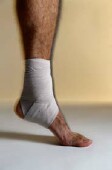
TUESDAY, Oct. 6, 2015 (HealthDay News) — After a broken ankle, many patients embark on an exercise-based rehabilitation program to help speed healing and regain mobility. But a new study out of Australia casts some doubt on whether these programs help.
The findings suggest that routine care for patients should not include “a supervised exercise program,” such as those typically provided in a physical therapy program,” wrote a team led by Anne Moseley, of the University of Sydney.
However, one U.S. expert contested the findings, noting that a third of patients initially enrolled in the trial dropped out to engage in “out of trial” physical therapy. This, “supports my view that rehabilitation is an essential component to restoration of pre-injury function,” said Dr. Neil Roth, an orthopedic surgeon at Lenox Hill Hospital in New York City.
The findings were published Oct. 6 in the Journal of the American Medical Association.
As the Australian team explained, after a broken ankle is repaired, patients typically go through a period of immobilization with a cast while the fracture heals.
In some cases, this is followed by rehabilitation that includes supervised exercise and self-management advice, but it’s been unclear whether or not this helps patients.
Moseley’s team randomly assigned 214 patients with an uncomplicated ankle fracture to either rehabilitation or advice alone after their immobilization cast was removed. Those in the advice group received a single session of information about exercise and a return to activity.
After six months, patients in both groups had achieved similar levels of activity and quality of life, the researchers reported.
“We have previously shown that recovery of activity limitation after ankle fracture is rapid in the first six months and that adding passive stretch or manual therapy to a supervised exercise program did not enhance the benefits of exercise alone,” Modesley’s group noted.
“It is possible that the lack of treatment effect we observed in this trial is attributable to the fact that rehabilitation cannot accelerate this rapid recovery,” the researchers said.
But Roth disagreed.
“While some ‘uncomplicated’ ankle fractures may have similar outcomes at 6 months after injury with or without rehabilitation, not all ankle fractures are alike,” he said. “The authors do not differentiate these types of ankle fractures, which can range from avulsion fractures — similar to an ankle sprain — or more significant non-displaced fractures.”
He said the fact that a third of patients dropped out to seek physical therapy elsewhere is also important to note.
“While lesser-demand patients with uncomplicated ankle fractures may do fine with home instruction versus supervised rehabilitation, it is my expert sports medicine opinion that physical therapy after ankle fractures — and even ankle sprain — shortens the time for patients and athletes to return to their pre-injury level of activity,” Roth said.
More information
Find out more about the care of broken or fractured ankles at the American Academy of Orthopaedic Surgeons.
Copyright © 2025 HealthDay. All rights reserved.

